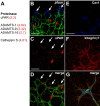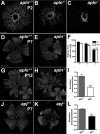Identification and functional analysis of endothelial tip cell-enriched genes
- PMID: 20705756
- PMCID: PMC4314527
- DOI: 10.1182/blood-2010-02-270819
Identification and functional analysis of endothelial tip cell-enriched genes
Abstract
Sprouting of developing blood vessels is mediated by specialized motile endothelial cells localized at the tips of growing capillaries. Following behind the tip cells, endothelial stalk cells form the capillary lumen and proliferate. Expression of the Notch ligand Delta-like-4 (Dll4) in tip cells suppresses tip cell fate in neighboring stalk cells via Notch signaling. In DLL4(+/-) mouse mutants, most retinal endothelial cells display morphologic features of tip cells. We hypothesized that these mouse mutants could be used to isolate tip cells and so to determine their genetic repertoire. Using transcriptome analysis of retinal endothelial cells isolated from DLL4(+/-) and wild-type mice, we identified 3 clusters of tip cell-enriched genes, encoding extracellular matrix degrading enzymes, basement membrane components, and secreted molecules. Secreted molecules endothelial-specific molecule 1, angiopoietin 2, and apelin bind to cognate receptors on endothelial stalk cells. Knockout mice and zebrafish morpholino knockdown of apelin showed delayed angiogenesis and reduced proliferation of stalk cells expressing the apelin receptor APJ. Thus, tip cells may regulate angiogenesis via matrix remodeling, production of basement membrane, and release of secreted molecules, some of which regulate stalk cell behavior.
Figures






Similar articles
-
Computational Screening of Tip and Stalk Cell Behavior Proposes a Role for Apelin Signaling in Sprout Progression.PLoS One. 2016 Nov 9;11(11):e0159478. doi: 10.1371/journal.pone.0159478. eCollection 2016. PLoS One. 2016. PMID: 27828952 Free PMC article.
-
Fzd7 (Frizzled-7) Expressed by Endothelial Cells Controls Blood Vessel Formation Through Wnt/β-Catenin Canonical Signaling.Arterioscler Thromb Vasc Biol. 2016 Dec;36(12):2369-2380. doi: 10.1161/ATVBAHA.116.307926. Epub 2016 Oct 6. Arterioscler Thromb Vasc Biol. 2016. PMID: 27758766
-
Synaptojanin-2 binding protein stabilizes the Notch ligands DLL1 and DLL4 and inhibits sprouting angiogenesis.Circ Res. 2013 Nov 8;113(11):1206-18. doi: 10.1161/CIRCRESAHA.113.301686. Epub 2013 Sep 11. Circ Res. 2013. PMID: 24025447
-
The role of extracellular matrix in vascular branching morphogenesis.Cell Adh Migr. 2012 Nov-Dec;6(6):528-34. doi: 10.4161/cam.22862. Epub 2012 Nov 1. Cell Adh Migr. 2012. PMID: 23257831 Free PMC article. Review.
-
[Apelin signalisation and vascular physiopathology].J Soc Biol. 2009;203(2):171-9. doi: 10.1051/jbio/2009021. Epub 2009 Jun 16. J Soc Biol. 2009. PMID: 19527631 Review. French.
Cited by
-
Vascularisation of the central nervous system.Mech Dev. 2015 Nov;138 Pt 1:26-36. doi: 10.1016/j.mod.2015.07.001. Epub 2015 Jul 26. Mech Dev. 2015. PMID: 26222953 Free PMC article. Review.
-
Specialized tip/stalk-like and phalanx-like endothelial cells from embryonic stem cells.Stem Cells Dev. 2013 May 1;22(9):1398-407. doi: 10.1089/scd.2012.0376. Epub 2013 Feb 12. Stem Cells Dev. 2013. PMID: 23249281 Free PMC article.
-
Single-cell analysis of multiple cancer types reveals differences in endothelial cells between tumors and normal tissues.Comput Struct Biotechnol J. 2022 Dec 30;21:665-676. doi: 10.1016/j.csbj.2022.12.049. eCollection 2023. Comput Struct Biotechnol J. 2022. PMID: 36659929 Free PMC article.
-
miRNA Levels as a Biomarker for Anti-VEGF Response in Patients with Diabetic Macular Edema.J Pers Med. 2021 Dec 4;11(12):1297. doi: 10.3390/jpm11121297. J Pers Med. 2021. PMID: 34945769 Free PMC article.
-
Endothelin-2 signaling in the neural retina promotes the endothelial tip cell state and inhibits angiogenesis.Proc Natl Acad Sci U S A. 2013 Oct 1;110(40):E3830-9. doi: 10.1073/pnas.1315509110. Epub 2013 Sep 16. Proc Natl Acad Sci U S A. 2013. PMID: 24043815 Free PMC article.
References
-
- Tammela T, Zarkada G, Wallgard E, et al. Blocking VEGFR-3 suppresses angiogenic sprouting and vascular network formation. Nature. 2008;454(7204):656–660. - PubMed
-
- Isogai S, Lawson ND, Torrealday S, Horiguchi M, Weinstein BM. Angiogenic network formation in the developing vertebrate trunk. Development. 2003;130(21):5281–5290. - PubMed
-
- Noguera-Troise I, Daly C, Papadopoulos NJ, et al. Blockade of Dll4 inhibits tumour growth by promoting non-productive angiogenesis. Nature. 2006;444(7122):1032–1037. - PubMed
Publication types
MeSH terms
Substances
Grants and funding
LinkOut - more resources
Full Text Sources
Other Literature Sources
Molecular Biology Databases

